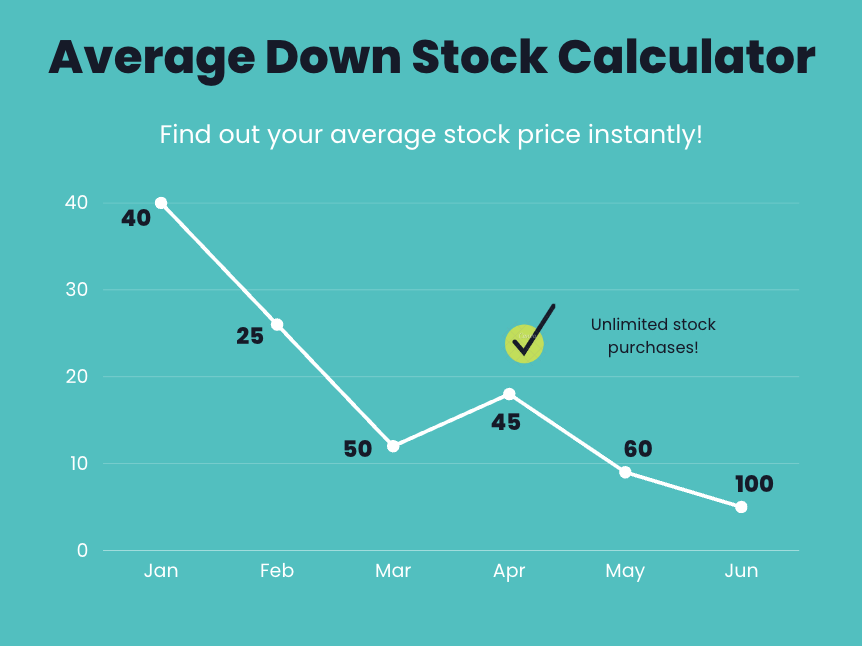Use our average down stock calculator to find out your average buy price for your stock investments with an unlimited number of rows.
Stock Average Down Calculator
Average Buy Price: 0.00
How to use the average down stock calculator:
- Add the amount of stock bought (e.g. 20, 150, or 1500)
- Add the buy price (e.g. 18, 50, or 250)
- Click “Add more” to add more stock buys.
The stock average down price calculator calculates the average buy price automatically and you can modify the rows as you want.
If you decide to remove a row, the calculator will automatically re-calculate your average stock price.
What is an average down stock calculator?

When trading without leverage an average stock cost calculator is a helpful tool for investors who are investing in stocks long-term.
It does a simple but important job:
- It figures out the average price you’ve paid for a stock when you’ve bought it at different times and at different prices.
- It can also tell you the average price you are going to pay if you plan to buy a stock when it is declining or rising.
Imagine you bought 30 shares of a company’s stock last year for $50 each, and now you’ve bought 30 more shares this year, but they cost you $40 each.
The average stock price calculator helps you find out the average price you’ve paid for all those shares together.
This average price is essential because it tells you the average cost of your investment, or in other words, where you break even on your investment.
So, in simple terms, an average stock calculator helps you see how much you’ve spent on a stock on average, even if you’ve bought it at different prices over time.
It’s a handy tool for managing your investments and making informed decisions about your stocks especially if you use leverage for stock trading.
How does the calculator work?
An average stock price calculator works by taking into account two main factors, the total number of shares bought, and the total amount spent on those shares.
Here’s how it works step by step:
- Input: The user provides information about their stock purchases, including the quantity (number of shares) and the price at which each batch of shares was acquired.
- Calculation: The calculator adds up the total number of shares bought and calculates the total amount spent by multiplying the number of shares with the prices for each purchase.
- Average Price: The calculator divides the total amount spent by the total number of shares to determine the average price per share.
This average price represents the average cost at which the investor has acquired the stock.
Below the average stock price, you will also be able to see how many stocks in total you have bought and the total amount of money spent on the stocks overall.
If you are using leverage when buying stocks, make sure to use our leverage stock calculator to know how much to spend.
How to use it
There are only two things you need to know in order to learn how to use to calculator.
- Step 1: Find your data – Collect data on each purchase of the stock, including the number of shares bought and the price per share.
- Step 2: Add it to the calculator – Enter this information into the calculator, in separate rows for each purchase.
The automatic calculation to determine the average stock price instantly.
Now it’s up to you and your investment strategy to make sense if the number you have got is worth the risk or if you need to change the plan.
Example of a calculation
Let’s say that you’ve been investing in a certain stock over time, and you’ve made several buy-ins at different prices.
We assume that you are not using leverage and in that case you don’t have to worry about your liquidaiton price.
Now you want to know your average price at which you’ve bought these stocks.
Example:
- First purchase: You bought 100 shares of the company’s stock at $50 per share. So, you spent 100 * $50 = $5,000 on this purchase.
- Second purchase: Later, you buy 50 more shares of the same stock, but this time they were priced at $45 per share. This purchase cost you 50 * $45 = $2,250.
- Third purchase: You decided to buy another 75 shares when the stock price dropped to $40 per share. So, this purchase added 75 * $40 = $3,000 to your investment.
Now, you want to calculate the average price at which you’ve bought these stocks.
The easy way is to use our stock average calculator which will calculate it instantly and automatically.
Or you can calculate it on your own, I’ve added an example of the manual calculation just for you to see how much time you are saving.
Calculation:
Add up the total amount spent on all your purchases and then divide it by the total number of stocks you’ve bought.
- Total amount spent: $5,000 (first purchase) + $2,250 (second purchase) + $3,000 (third purchase) = $10,250
- Total Number of Shares Bought: 100 shares (first purchase) + 50 shares (second purchase) + 75 shares (third purchase) = 225 shares
Now, divide the total amount spent ($10,250) by the total number of shares (225 shares):
Average Price = Total Amount Spent / Total Number of Shares = $10,250 / 225 shares ≈ $45.56 per share
So, the average price at which you’ve acquired these stocks is $45.56 per stock.
Calculation formula
The formula for calculating the average stock price is:
Average Price = (Total Amount Spent) / (Total Number of Shares Bought)
Why you is this calculation important?
Calculating the average stock cost is important for a few key reasons:
- Tracking your investment: It helps you keep a close eye on how much you’ve spent on your stocks over time. Let’s say you buy stocks of a company at different prices on different days which can be difficult to keep in your head. This helps you understand where your break-even price is.
- Making decisions: When you know your average cost, you can better understand if it is worth it to make another purchase of the same stock. If the current stock price is below your average cost, you might consider buying more to reduce your overall cost per share. This strategy is called dollar-cost-averaging.
- Reporting your taxes: It can help you out big time when it’s time to report your taxes for the year. When you sell your stock you are obligated to pay capital gains taxes if you made a profit.
Benefits and drawbacks
Benefits:
- Lowering your average cost: Averaging down helps reduce the average price you’ve paid for a stock. When the stock’s price drops, you buy more to get a lower average.
- Potential for higher profits: A lower average cost means that when the stock price eventually rises, your potential profits can be higher. If you accumulate a lot of stock at lower prices, this can offset previous losses when the prices rise.
- Risk management: Averaging down can be a strategy to manage risk. Since most beginners lack the skills to time the market correctly, simply buying in when prices fall gives you an edge.
- Long-term investment: For investors who are focused on the long-term strategy it can be wise to try to average down to accumulate as much stock as possible for a cheaper price. Long-term leverage investing can be a decent strategy if you have patience.
Drawbacks:
- Loss amplification: Averaging down can backfire if the stock’s price continues to fall. Buying more while the prices are in a free-fall can create huge losses if the stock doesn’t recover.
- Tied-up capital: Investing more money with a dollar-cost-averaging strategy ties up your capital during a longer period which limits your flexibility if a short-term opportunity comes up.
- Uncertain future: Averaging down assumes that the stock will eventually recover and investors who try to bottom-pick low-quality stocks might never get a return on their money. Make sure to pick quality over quantity.
FAQ
To calculate average stock value, divide the total value of your stock holdings by the total number of shares you own.
Averaging stock prices means buying more shares of a stock at lower prices to reduce your average cost per share. It’s a strategy to lower your overall investment cost.


 Trade Stocks with 0 Commissions – Join eToro Today!
Trade Stocks with 0 Commissions – Join eToro Today!